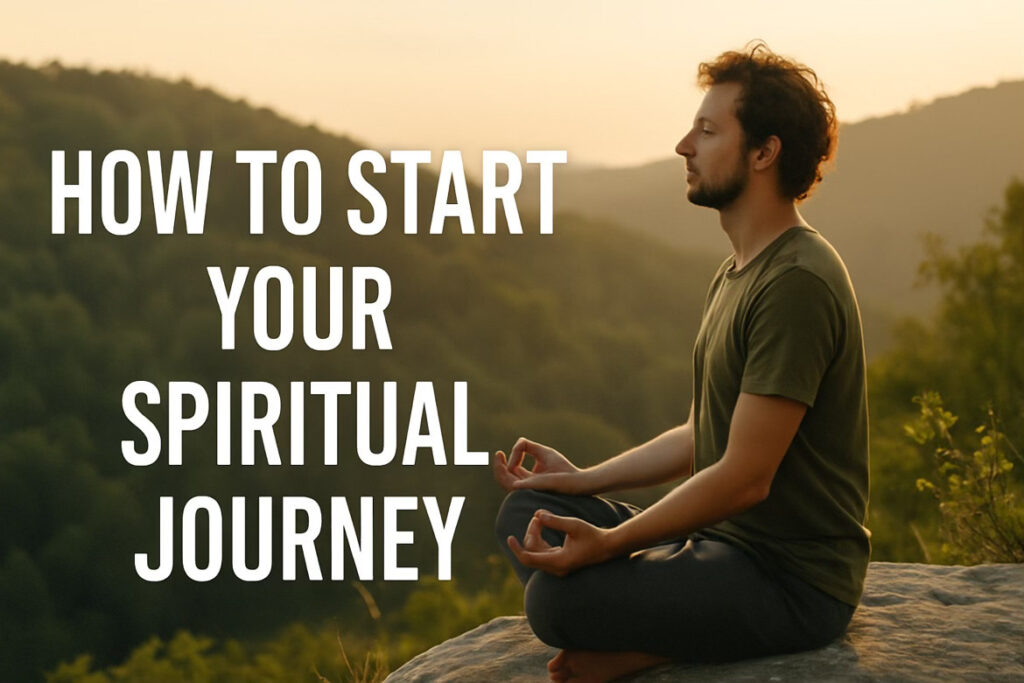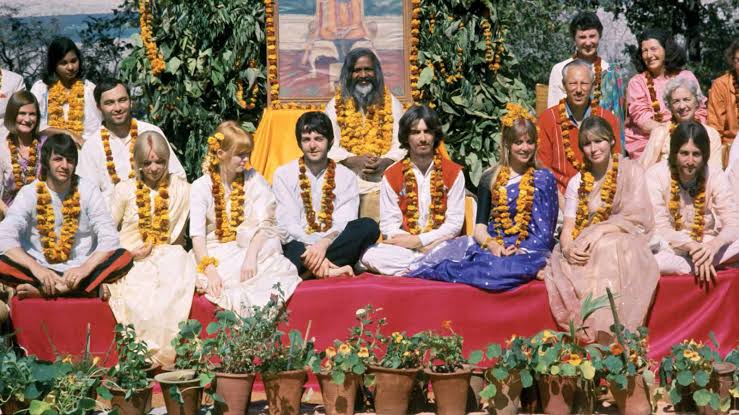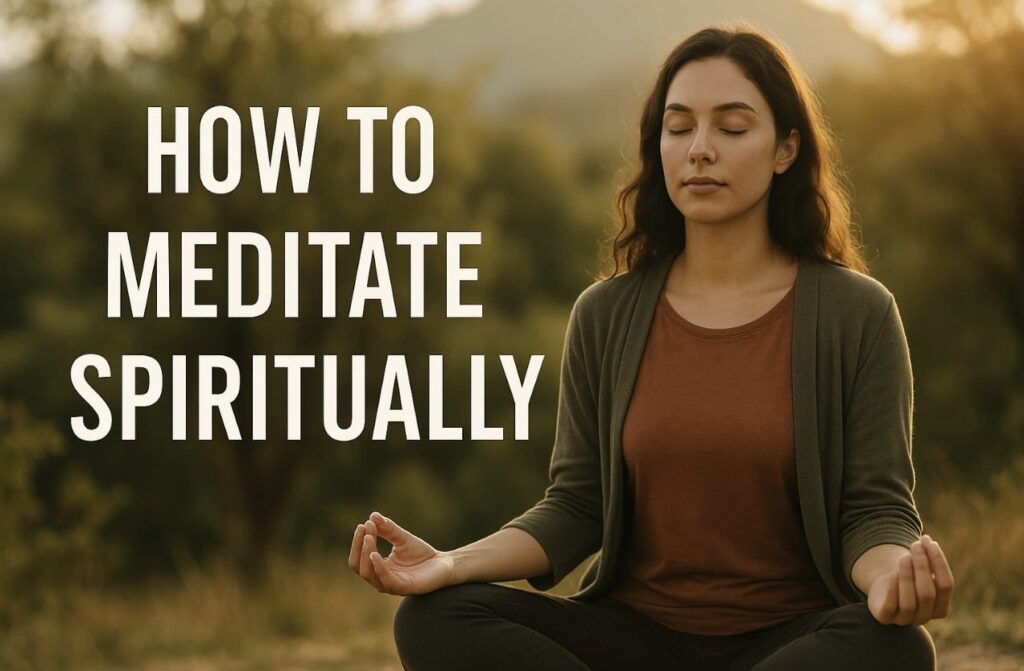
Before we explore how to start your spiritual journey, it’s important to understand what spirituality actually means.
Spirituality isn’t about rituals, blind faith it’s about asking the big questions.
Why are we here? Why were you born a human, while another life takes form as an animal? These aren’t questions with easy answers, but that’s exactly what makes the search so powerful.
It’s about trying to understand the soul your true self beyond the physical body or what the world expects of you.
Think about it like this: you can’t see energy with your eyes, but you can feel it. You don’t see sunlight itself you feel its warmth on your skin. In the same way, we might not be able to see the soul, but its presence is very real. And when you start tuning in, you begin to sense it.
How to become spiritual? Spirituality is about connection not division. Where religion can sometimes separate us through labels and systems, true spirituality brings people together. It reminds us that beneath it all, we’re more than just our names, beliefs, or roles—we’re all part of something deeper.
“Spirituality unites, but religion divides”
How to Start Your Spiritual Journey?
All the practices are mention below with much simple and easily practicable way ,Let’s dive into it.
Table of Contents
Let’s start our spiritual journey
1.Start with Self-Inquiry
The spiritual journey begins not outside, but within. It starts with honest, courageous self enquiry asking the questions that most people avoid in daily life, yet hold the key to deeper understanding.
Begin by asking yourself:
- Why am I here?
What is the reason for my existence in this vast universe? - What is the purpose of my life?
Is it just to work, earn, and survive or is there something more profound? - What lies beyond what I see and touch?
Is there a reality beyond the material world? - Who am I beyond my job or roles?
Am I just a parent, a student, a professional or something deeper than these identities? - What brings me lasting peace or joy?
What uplifts my soul, not just excites my senses?
You don’t need immediate answers. In fact, the power lies in holding the questions gently and patiently. Sit with them in silence. Journal your thoughts. Notice how your awareness begins to shift.
This practice of enquiry opens the door to spiritual awakening. It helps peel away the layers of ego and conditioning to reveal the truth of who you really are.
2.Practice Stillness and Presence
In a world full of noise, distractions, and constant motion, stillness is revolutionary. Yet it’s in stillness that spirituality speaks the loudest.
Spiritual growth isn’t something that can be rushed or forced it unfolds naturally when we become fully present in the moment. Practicing stillness allows us to focus on our goal,our aim to achieve something big in terms of spirituality,awakening and help us find inner peace,which is our ultimate goal.
Why Stillness Matters
- It calms the overactive mind.
- It opens space for clarity and intuition.
- It reconnects you with the now, where all spiritual wisdom begins.
Simple Ways to Begin
- Meditation: Sit quietly for even 5–10 minutes. Focus on your breath or repeat a calming mantra ‘OM’ .
- Mindful breathing: Throughout the day, pause and take slow, conscious breaths.
- Silent observation: Spend time simply observing nature, your surroundings, your own thoughts without judgment.
- Digital detox moments: Step away from screens. Give yourself space to be without stimulation.
3.Read spiritual text
India, known as the land of yoga and inner science, offers some of the most profound spiritual literature in the world. These ancient scriptures don’t just inform they transform. They don’t ask you to blindly believe; they invite you to experience.
Key Indian Texts to Begin With
- Bhagavad Gita: A conversation between Lord Krishna and warrior Arjuna, the Gita is a guide to life, purpose, duty, and self realization. It covers all paths of yoga—karma yoga (selfless action), bhakti yoga (devotion), and jnana yoga (knowledge).
- Upanishads: These are philosophical texts that explore the nature of reality, the self (Atman), and the ultimate truth (Brahman). They dive deep into consciousness and existence.
- Yoga Sutras of Patanjali: A foundational text for understanding the practice and purpose of yoga—not just the physical postures, but the mental and spiritual discipline behind them.
- Srimad Bhagavatam: Rich with stories of divine play (leela), devotion, and spiritual insight, this scripture emphasizes bhakti (devotion) as a path to the divine.
4.Practice Yoga to Align Body,Mind and Spirit
How to get into spirituality? Well,simple answer is start with .Yoga is far more than physical exercise—it’s a spiritual science. Rooted in ancient Indian wisdom, yoga was designed as a tool to unite the body, mind, and soul, and ultimately lead you to self-realization.
The word “yoga” comes from the Sanskrit root “yuj”, which means to unite the union of the individual self with the universal consciousness.
Yoga Is a Path, Not Just a Practice
In the Indian tradition, there are different forms of yoga based on your temperament and spiritual inclination:
• Karma Yoga – the path of selfless action
• Bhakti Yoga – the path of devotion and love for the divine
• Jnana Yoga – the path of knowledge and self-inquiry
• Raja Yoga – the path of meditation and discipline
Also Read:How to meditate spiritually: A Simple Guide for Beginners
Thinking of Learning Yoga? Rishikesh Is the Perfect Place to Begin

If you’re serious about deepening your yoga practice not just physically, but spiritually—Rishikesh is one of the best places to start. Known as the Yoga Capital of the World, this sacred town in northern India rests on the banks of the holy Ganges River, surrounded by the Himalayan foothills.
5.Connect With Nature
Nature is not just scenery it’s a sacred space, a living expression of the divine. It is a beautiful gift from God, and one of the most accessible paths to spiritual connection.
Animals, trees, rivers they don’t question their purpose. They simply exist in harmony with the universe. As humans, we’ve become disconnected from this natural rhythm. But when we return to nature, we begin to return to ourselves.
6.Cultivate Gratitude and Compassion
Two of the most powerful spiritual tools gratitude and compassion don’t require rituals or scriptures. They are daily practices that open your heart and dissolve ego, helping you live from a place of love rather than fear.
Gratitude is the art of recognizing the blessings already present in your life.
It shifts your focus from what’s missing to what’s already abundant. When you’re grateful, you naturally feel more peaceful, present, and connected.
Try this:
- Every morning or night, write down 3 things you’re grateful for no matter how small.
- Thank life for your breath, your food, your challenges, and your growth.
- Notice the beauty in the ordinary sunlight, a smile, the rhythm of your heartbeat.
Compassion is the understanding that every being is on their own journey.
It teaches us to respond with kindness, even when it’s difficult. When you act from compassion, you’re not just helping others you’re freeing yourself from judgment and separation.
Practice compassion by:
- Listening without needing to respond
- Forgiving more quickly
- Offering help without expecting anything in return
Together, gratitude and compassion soften the heart and deepen your connection to all living things—a direct experience of spiritual unity
7.Find a Spiritual Mentor or Community
In today’s world, where superficiality often overshadows sincerity, finding a true spiritual mentor or Guru can feel like searching for light in a fog. The world is full of noise, ego, and imitation and many who appear “spiritual” are only playing the part.
A real Guru is not defined by external symbols not by their beard, bald head, clothing, or social media following.
A Guru is a divine presence who dispels ignorance (gu = darkness, ru = remover), not someone who simply looks the part.
Unfortunately, our modern, materialistic mindset tends to evaluate even spirituality through the lens of appearance:
- “Does he look enlightened?”
- “What kind of clothes does she wear?”
- “How many followers does he have?”
But the true test of a Guru lies not in what they wear, but in how you feel in their presence:
- Do they inspire peace, clarity, and truth within you?
- Do they guide you inward instead of making you dependent?
- Do they live what they teach?
“A true Guru doesn’t make you follow them they help you follow yourself.”
Approach the idea of a Guru with humility, discernment, and openness. Trust your intuition more than your eyes. The right teacher appears when the student is truly ready not just curious, but sincerely seeking.
8.Let Go of What No Longer Serves You
Letting go doesn’t mean hatred or resentment. It means recognizing what’s holding you back from your inner peace, and gently choosing freedom.
Sometimes, that means:
- Walking away from toxic relationships that drain your energy or keep you stuck in negativity.
- Releasing material obsessions that only feed the ego, not the heart.
- Letting go of the need to control everything, or the fear of being alone.
“If something costs you your peace, it’s too expensive.”
9.Be Patient with the process
A spiritual journey is not a destination it’s a lifelong process. There’s no final checkpoint, no certificate, no perfect version of yourself waiting at the end. It’s about becoming more conscious, more connected, and more true to your inner self, one step at a time.
Yes, you may have doubts. You may feel uncertain. You might question whether you’re on the right path. But know this doubt is not a weakness. It’s part of the spiritual unfolding. It means you’re thinking, feeling, and honestly searching for truth.
“Doubt is the beginning of wisdom not the end of faith.”
Don’t rush. Don’t compare. Your journey is sacred and unique.
Keep asking. Keep listening. Keep returning to your soul.
In time, the fog will clear, the noise will quiet down, and what will remain is you—more aware, more free, more aligned with your highest self.
10.Integrate Spirituality into Daily Life
Whatever you gain from your inner journey peace, patience, awareness, compassion—let it reflect in your daily life. That is the true measure of spiritual growth.
- Speak with kindness, even when it’s hard.
- Act with integrity, even when no one is watching.
- Be present with people, not just your thoughts.
- Choose love over ego, and truth over comfort
Spiritual Journey: Frequently Asked Questions (FAQs)
1. What is a spiritual journey?
A spiritual journey is an inward exploration of your true self, purpose, and connection with the universe or divine. It’s less about external achievements and more about inner transformation, peace, awareness, and awakening.
2. Where should I start my spiritual journey?
Start with self-inquiry. Ask deep, honest questions like:
- Who am I beyond my roles?
- Why am I here?
- What brings me true peace and joy?
These questions gently guide your awareness inward and begin the process of awakening.
3. Do I need a religion to be spiritual?
No. Spirituality is not confined to any religion. You can follow a religion or none at all. Spirituality is a personal experience of truth, peace, and connection that transcends belief systems.
4. What is the role of stillness or meditation in spirituality?
Stillness helps calm your mind and connect you to the present moment—the gateway to all spiritual insight. Meditation, mindful breathing, and silent observation are simple yet powerful tools to begin with.
5. Which spiritual texts should I read first?
Some foundational Indian spiritual texts include:
- Bhagavad Gita – on life, purpose, and duty
- Upanishads – on the nature of self and reality
- Yoga Sutras of Patanjali – on yoga as a spiritual path
- Srimad Bhagavatam – on devotion and divine play
6. What is yoga’s connection to spirituality?
Yoga means “union” and is a system designed to harmonize the body, mind, and soul. It includes:
- Karma Yoga – service
- Bhakti Yoga – devotion
- Jnana Yoga – knowledge
- Raja Yoga – meditation and discipline
It’s much more than physical postures—it’s a path to self-realization.
7. Why is nature important on the spiritual path?
Nature is a silent teacher. Observing its harmony, simplicity, and presence can ground you, humble you, and remind you of your own true nature. Time in nature can feel like a direct connection to the divine.
8. How do gratitude and compassion help in spiritual growth?
Gratitude shifts your perspective from lack to abundance. Compassion dissolves separation and ego. Together, they open your heart and connect you deeply to yourself and others.
9. Do I need a spiritual teacher or Guru?
Not always, but a true Guru can help illuminate your path. The right teacher:
- Guides you inward
- Inspires peace and clarity
- Lives what they teach
But discern wisely—spiritual appearance does not equal authenticity. Trust your intuition.
10. What does it mean to ‘let go’ on the spiritual path?
Letting go means releasing attachments, fears, toxic relationships, or habits that no longer serve your peace or growth. It’s not rejection—it’s choosing freedom and alignment with your higher self.
11. What if I feel stuck, doubtful, or lost on this journey?
That’s completely normal. Doubt is not failure—it’s a sign of honest searching. Be patient with yourself. The path unfolds gradually. Keep practicing, asking, and listening. You’re growing even when it doesn’t feel like it.
12. How do I integrate spirituality into my daily life?
True spirituality reflects in how you live:
- Speak and act with kindness
Hi, I’m Swaraj Das a registered pharmacist by profession and a passionate blogger at heart. I love writing about wellness, spirituality, uplifting lifestyle tips, practical life lessons, and inspiring stories. Through my words, I aim to bring clarity, motivation, and well being to everyday life.


